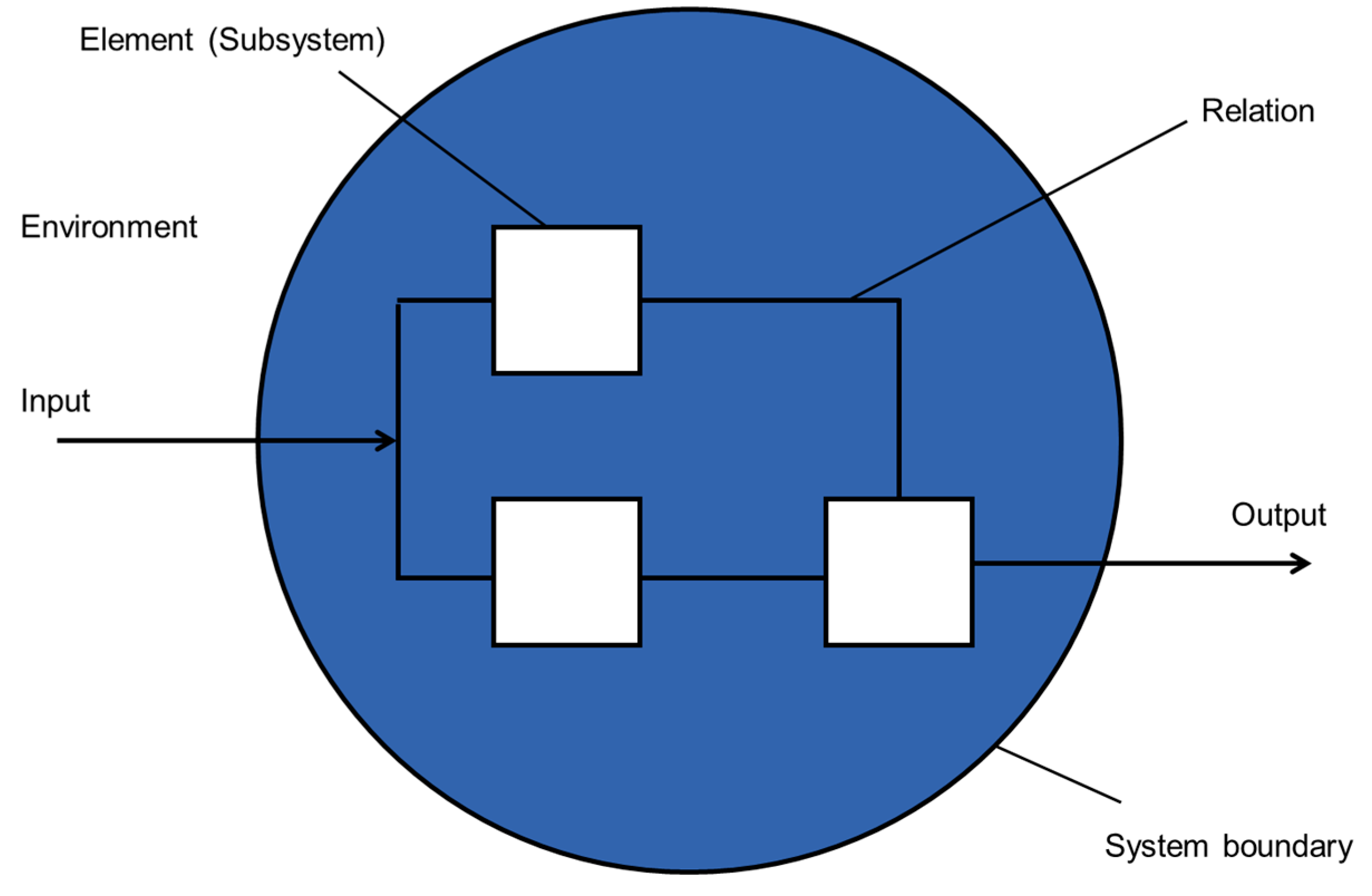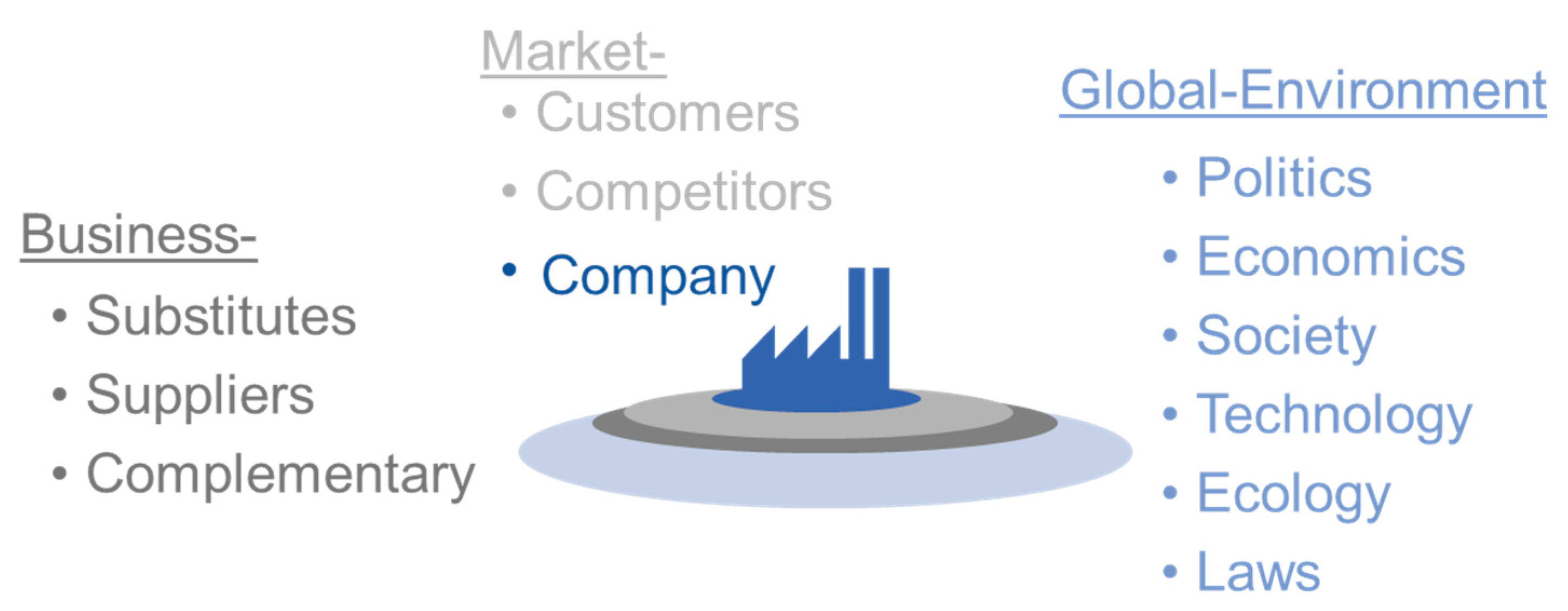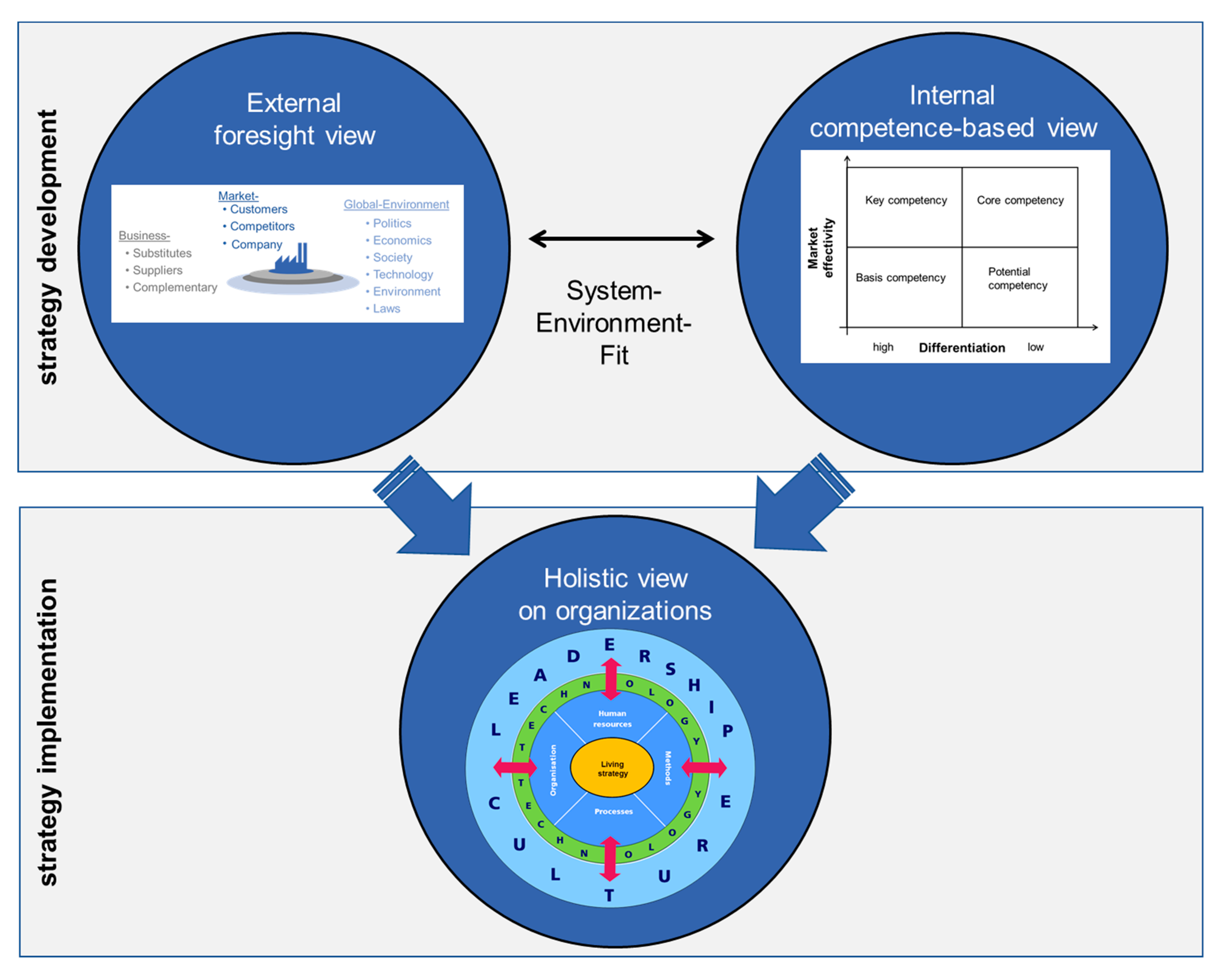A Systems Thinking Approach to Corporate Strategy Development
Abstract
:1. Introduction
2. The Firm and Its Environment: Seeing Companies as a System
3. A Systems Thinking Approach to Strategy Development
3.1. Strategic Foresight and Scenarios: A Methodical Approach to Analyzing a Firm’s Environment
3.2. Differentiation of Competencies: A Methodical Approach to Analyzing a Firm’s Potential
4. A Holistic Model for Implementing Strategy in the Company
5. Conclusions
Author Contributions
Funding
Acknowledgments
Conflicts of Interest
References
- Kiliko, J.; Atandi, B.; Zachary, A. Strategic planning in turbulent environment: A Conceptual View. DBA Afr. Manag. Rev. 2012, 3, 73–89. [Google Scholar]
- Grant, R.M. Strategic planning in a turbulent environment: Evidence from the oil majors. Strat. Mgmt. J. 2003, 24, 491–517. [Google Scholar] [CrossRef]
- Ackoff, R.L. On the use of models in corporate planning. Strateg. Manag. J. 1981, 2, 353–359. [Google Scholar] [CrossRef]
- Mainzer, K. Thinking in Complexity. The Computational Dynamics of Matter, Mind, and Mankind, 4th ed.; Springer: Berlin/Heidelberg, Germany, 2004; ISBN 9783662053669. [Google Scholar]
- Blackwell, D. Equivalent Comparisons of Experiments. Ann. Math. Statist. 1953, 24, 265–272. [Google Scholar] [CrossRef]
- Davenport, T.H.; Harris, J.G. Competing on Analytics. The New Science of Winning; Harvard Business School Press: Boston, MA, USA, 2007; ISBN 9781422103326. [Google Scholar]
- Galbraith, J.R. Organization Design: An Information Processing View. Interfaces 1974, 4, 28–36. [Google Scholar] [CrossRef]
- Galbraith, J.R. The Future of Organization Design. J. Org. Des. 2012, 1, 3. [Google Scholar] [CrossRef] [Green Version]
- Tyssen, M.; Schneider, C.; Gleich, R.; Wald, A. Corporate Foresight in kleinen und mittleren Unternehmen. ZfKE Z. KMU Entrep. 2012, 60, 1–28. [Google Scholar] [CrossRef]
- Maani, K.E.; Cavana, R.Y. Systems Thinking and Modelling. Understanding Change and Complexity, Repr; Pearson Education: Albany, NY, USA, 2004; ISBN 9781877258008. [Google Scholar]
- Richmond, B. An introduction to systems thinking. Ithink software; High Performance Systems: Hanover, NH, USA, 2001; ISBN 9780970492104. [Google Scholar]
- Ropohl, G. Allgemeine Technologie: Eine Systemtheorie der Technik; Univ.-Verl. Karlsruhe: Karlsruhe, Germany, 2009; ISBN 9783866443747. [Google Scholar]
- Luhmann, N. Soziale Systeme. Grundriß Einer Allgemeinen Theorie; Suhrkamp Verlag: Berlin, Germany, 1987; ISBN 3518282662. [Google Scholar]
- Weissenberger-Eibl, M.A. Innovationsforschung—ein Systemischer Ansatz.: Merkmale, Methoden und Herausforderungen. In Denkströme Heft 17; Präsident der Sächsischen Akademie der Wissenschaften zu Leipzig; Leipziger Universitätsverlag: Leipzig, Germany, 2017; pp. 33–56. [Google Scholar]
- Weissenberger-Eibl, M.A.; Koch, D.J. Innovation—Technologie—Entrepreneurship. Gestaltungssystem der frühen Phase des Innovationsprozesses; Cactus-Group-Verl.: Karlsruhe, Germany, 2013; ISBN 978-3-937289-11-3. [Google Scholar]
- Weissenberger-Eibl, M.A.; Koch, D.J. Innovationssysteme in Mittel- und Osteuropa. Akteure, Aktionsfelder, Länderprofile; Cactus-Group-Verl.: Kassel, Germany, 2007; ISBN 9783937289045. [Google Scholar]
- Mele, C.; Pels, J.; Polese, F. A Brief Review of Systems Theories and Their Managerial Applications. Serv. Sci. 2010, 2, 126–135. [Google Scholar] [CrossRef] [Green Version]
- Rüegg-Stürm, J. Das neue St. Galler Management-Modell. Grundkategorien einer Modernen Managementlehre; Haupt: Bern, Switzerland, 2007; ISBN 978-3-258-06629-5. [Google Scholar]
- Porter, M.E. Towards a dynamic theory of strategy. Strateg. Manag. J. 1991, 12, 95–117. [Google Scholar] [CrossRef] [Green Version]
- Tversky, A.; Kahneman, D. Rational Choice and the Framing of Decisions. J. Bus. 1986, 59, S251. [Google Scholar] [CrossRef] [Green Version]
- Liu, G.; Harris, S. Group Conflicts and Faultlines: The Behavioural Dynamics of Top Management Teams. In Proceedings of the EURAM 2018 Conference, Reykjavík, Iceland, 19–22 June 2018. [Google Scholar]
- Samuelson, W.; Zeckhauser, R. Status quo bias in decision making. J. Risk Uncertain. 1988, 1, 7–59. [Google Scholar] [CrossRef] [Green Version]
- Müller, A.W.; Müller-Stewens, G. Strategic Foresight. Trend- und Zukunftsforschung in Unternehmen—Instrumente, Prozesse, Fallstudien; Schäffer-Poeschel Verlag: Stuttgart, Germany, 2009; ISBN 9783791028682. [Google Scholar]
- Fink, A.; Siebe, A. Handbuch Zukunftsmanagement. Werkzeuge der strategischen Planung und Früherkennung; Campus-Verl.: Frankfurt am Main, Germany, 2006; ISBN 9783593378046. [Google Scholar]
- Rohrbeck, R. Corporate Foresight. Towards a Maturity Model for the Future Orientation of a Firm; Physica-Verlag: Berlin, Germany, 2011; ISBN 9783790826265. [Google Scholar]
- Tyssen, M. Zukunftsorientierung und dynamische Fähigkeiten. Corporate Foresight in Unternehmen der Investitionsgüterindustrie; Springer Gabler: Wiesbaden, Germany, 2012; ISBN 9783834938954. [Google Scholar]
- Postma, T.J.B.M.; Broekhuizen, T.L.J.; van den Bosch, F. The contribution of scenario analysis to the front-end of new product development. Futures 2012, 44, 642–654. [Google Scholar] [CrossRef]
- Gausemeier, J.; Plass, C. Zukunftsorientierte Unternehmensgestaltung. Strategien, Geschäftsprozesse und IT-Systeme für die Produktion von morgen, 2., überarb. Aufl.; Hanser: München, Germany, 2014; ISBN 978-3-446-43842-2. [Google Scholar]
- Rohrbeck, R. Trend Scanning, Scouting and Foresight Techniques. In Management of the Fuzzy Front End of Innovation; Gassmann, O., Schweitzer, F., Eds.; Springer: Cham, Switzerland, 2014; pp. 59–73. ISBN 978-3-319-01055-7. [Google Scholar]
- Drew, S.A.W. Building technology foresight: Using scenarios to embrace innovation. Eur. J. Innov. Manag. 2006, 9, 241–257. [Google Scholar] [CrossRef]
- Ansoff, H.I. Managing Strategic Surprise by Response to Weak Signals. Calif. Manag. Rev. 1975, 18, 21–33. [Google Scholar] [CrossRef]
- Penrose, E.T. The Theory of the Growth of the Firm, 4th ed.; Oxford University Press: Oxford, UK, 2009; ISBN 9780199573844. [Google Scholar]
- Hamel, G.; Prahalad, C.K. Competing for the Future, [Nachdr.]; Harvard Business School Press: Boston, MA, USA, 2007; ISBN 9780875847160. [Google Scholar]
- Helfat, C.E.; Finkelstein, S.; Mitchell, W.; Peteraf, M.A.; Singh, H.; Teece, D.J.; Winter, S.G. Dynamic Capabilities: Understanding Strategic cHange in Organizations; Blackwell Publishing: Malden, MA, USA; Oxford, UK, 2007; ISBN 978-1-4051-8206-5. [Google Scholar]
- Wildemann, H. Innovationsmanagement. Leitfaden zur Einführung eines effektiven und effizienten Innovationsmanagementsystems; 17. Auflage 2017; TCW Transfer-Centrum Verl.: München, Germany, 2017; ISBN 978-3-931511-94-4. [Google Scholar]
- Camillus, J.C. Strategy as a Wicked Problem. Harv. Bus. Rev. 2008, 86, 98–106. [Google Scholar]
- Mintzberg, H.; Ahlstrand, B.W.; Lampel, J. Strategy Safari. The Complete Guide through the Wilds of Strategic Management, 7th ed.; FT Prentice Hall Financial Times: Harlow, UK; London, UK; New York, NY, USA; Boston, MA, USA; San Francisco, CA, USA; Toronto, ON, Canada, 2009; ISBN 9780273719588. [Google Scholar]
- Raps, A. Strategy implementation—An insurmountable obstacle? Handb. Bus. Strateg. 2005, 6, 141–146. [Google Scholar] [CrossRef]
- Sterling, J. Translating strategy into effective implementation: Dispelling the myths and highlighting what works. Strateg. Leadersh. 2003, 31, 27–34. [Google Scholar] [CrossRef]
- Hrebiniak, L.G. Obstacles to Effective Strategy Implementation. Organ. Dyn. 2006, 35, 12–31. [Google Scholar] [CrossRef]
- Weissenberger-Eibl, M.A.; Spieth, P. Knowledge Transfer: Affected by Organisational Culture? In Proceedings of the 6th International Conference on Knowledge Management (I-Know ’06), Graz, Austria, 6–8 September 2006; Tochtermann, K., Maurer, H., Eds.; Know-Center: Graz, Austria, 2006; pp. 68–75. [Google Scholar]






© 2019 by the authors. Licensee MDPI, Basel, Switzerland. This article is an open access article distributed under the terms and conditions of the Creative Commons Attribution (CC BY) license (http://creativecommons.org/licenses/by/4.0/).
Share and Cite
Weissenberger-Eibl, M.A.; Almeida, A.; Seus, F. A Systems Thinking Approach to Corporate Strategy Development. Systems 2019, 7, 16. https://0-doi-org.brum.beds.ac.uk/10.3390/systems7010016
Weissenberger-Eibl MA, Almeida A, Seus F. A Systems Thinking Approach to Corporate Strategy Development. Systems. 2019; 7(1):16. https://0-doi-org.brum.beds.ac.uk/10.3390/systems7010016
Chicago/Turabian StyleWeissenberger-Eibl, Marion A., André Almeida, and Fanny Seus. 2019. "A Systems Thinking Approach to Corporate Strategy Development" Systems 7, no. 1: 16. https://0-doi-org.brum.beds.ac.uk/10.3390/systems7010016



